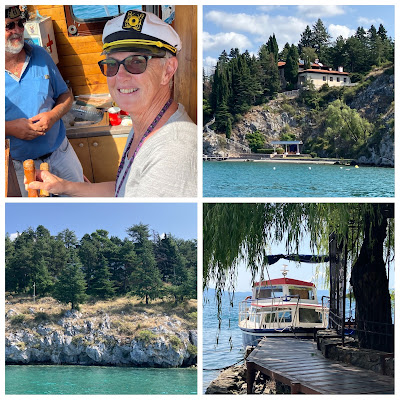September 1st - Lake Ohrid
Out on a boat trip on Lake Ohrid this morning to visit some of the sights along the coastline. Straddling the border between Albania and North Macedonia and with a surface area of 1382 miles (3582 kms), larger than the island of Malta, the lake itself is enormous. It also happens to be one of Europe’s deepest with a maximum depth of around 300 metres.
First visit for the day was for a swim just off the shore at Villa Biljana, a complex of villas formerly owned by ex-president and dictator Josip Tito. Due to the security (the buildings and beach are now owned by the government) landing was a no no which is a shame as a beach-side elevator apparently takes you right into the middle of the villa.
Our next stop was to the Church of St John at Kaneo, a Macedonian Orthodox Church dedicated to John of Patmos, author of ‘Revelations’ (and apparently the same person as John the Apostle!). Built in the 14th century, this little picturesque church, with fantastic views over Lake Ohrid, is supposedly is the most photographed building in town.
Our next destination was the ‘Bay of Bones’ museum, an authentic reconstruction of a pile dwelling settlement from around 700 B.C. Apparently the residents in the Lake Ohrid area around this time lived on platforms over the lake and with each village having its own wooden bridge from platform to shore. This museum is one of those platform-villages partially reconstructed on the site where it was originally discovered (the name ‘Bay of Bones’ itself stems from the fact that during the archeological excavations loads of animal bones were found on site). They’ve done a really good job of the actual building of the museum, and it was really interesting to see the village in-situ, unfortunately though the site was sadly lacking in any written information which was a bit of a disappointment.
Our last visit of the day was to the Monastery of St Naum, an Eastern Orthodox monastery and church sitting on the border of Albania with fantastic views overlooking Lake Ohrid. Originally dating from the 9th century, and dedicated to St Naum, one of the chief architects of the Cyrillic language, the present buildings are from between the 15th & 1600’s. The church, where St Naum is buried, is decorated with some magnificent frescoes with scenes from the Saint himself. Although presently in North Macedonia this land previously belonged to Albania, but in 1925 King Zog ceded it to Yugoslavia as a gesture of goodwill.











Comments
Post a Comment